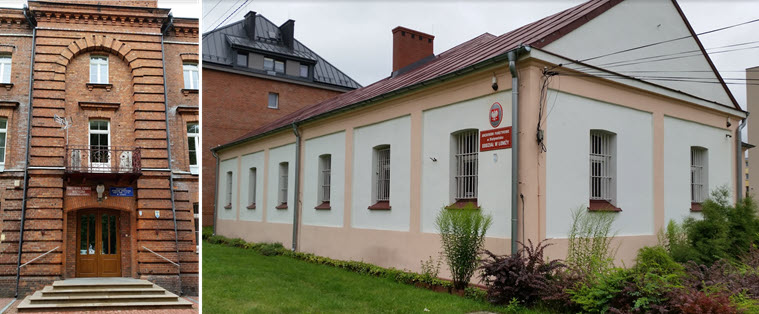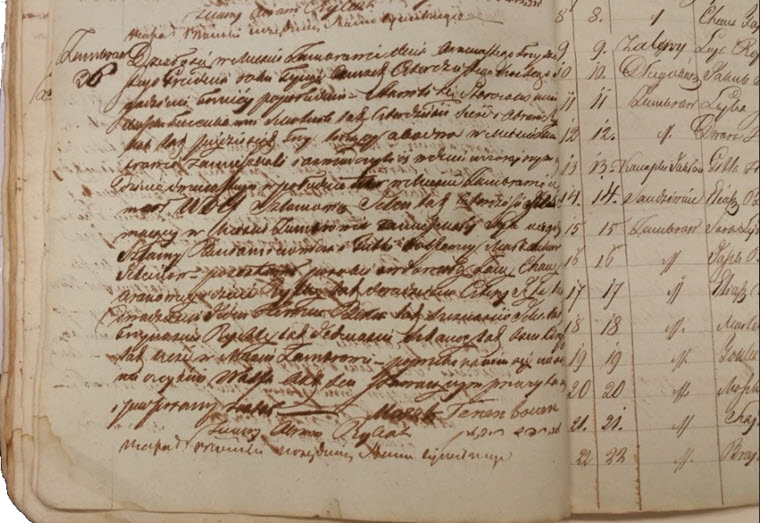Having spent time in Warsaw and Zambrow, I next tried to visit Piatnica where my Oconefsky’s were from, but it was raining so hard that I barely got out and drove on to Jedwabne. I had planned to go there the next day, so I didn’t actually know where the memorial was. Nor did I find anyone who spoke English. I found lots of churches, a town square and Christian cemeteries. Annoyed with myself for the just-in-time planning, I left Jedwabne unfulfilled, vowing to do it right the day after.
It was a day to be indoors, so I decided to visit the archives in Lomza (pronounced Womja). I had the exact street address and the satnav on my phone got me straight there. At the address was an impressive red brick building that looked governmental. I was a bit scared that no-one inside spoke English. This turned out to be true; however somehow, I managed to look helpless enough to be shown through to the back door and pointed to a completely different building that looked like a portacabin. I was at the right address but in the wrong building! The real archives were much more promising, especially because there were linguists present – in particular the delightful Danuta Bzura, the chief archivist. A useful mix of English, Polish, Russian and a smattering of Hebrew from me were used over the next 4 hours to great effect.

After filling in some forms with my name and passport details in triplicate, what followed was a frenzy of photography capturing as many of the records as I could order, year by year, record by record. There were far too many to do all the records, indeed far too many to do all of my people. Instead, I focused on one name: Wolf Jelen (my triple great grandfather) and all the associated children, siblings, parents and their siblings etc. I had partially done the research before based on JRI-Poland indexes (Jewish Records Indexing – Poland found at jri-poland.org), but they are not nearly as complete as the records themselves. I quite quickly managed to distinguish between the five different Wolf Jelen’s based on patronymics and confirmed which was actually the one I wanted. To be honest I’m related to the other four too, but not in a direct line, as after my Wolf died a pack of Wolves appeared as grandchildren in the usual Ashkenazi way.

Later, when I had returned to England, and with the help of JewishGen Viewmate for Polish and Russian translations (www.jewishgen.org/viewmate), I managed to go back two further generations to Szlama Jelen and his father Benjamin Jelen who must have been born circa 1750. That is my pentuple (5 times) great grandfather! I even have plans to make an assault on the sextuples, as I think I missed a death record of Szlama’s wife Gutka from 1825. This is going to get tricky because now I need to move into the world of Jews being mixed into the Catholic records and before the time when Jews took surnames. Gulp.
When I started the trip, I believe my ancestral home was Zambrow, and that was why I had booked a hostel there. However, I now realised that the real ancestral shtetl (settlement) was Sniadowo because that was where the previous two generations had started, although you could see the movement to Zambrow from Sniadowo in the records.
So that night I drove to Sniadowo, not far from Zambrow. Due to my phone battery running low, I decided to forego the satnav and just drive, using road signs. The genealogical force was strong, and I found it easily. After all, my ancestors had no satnav. Somewhere deep in my DNA is the knowledge of how to get around the Lomza district.
There was very little to be found in Sniadowo of a Jewish nature, but the town square was pleasant, and there were nice wooden houses to give me that 19th century feel – maybe even 18th century. But it was just a feeling because the houses were much more modern.
My final day in Poland fixed the errors of the previous days. I found the memorial in Jedwabne, and despite the rain took loads of pictures. It was well hidden, at the end of a country lane, surrounded by open fields. The memorial is a barn door set into stone. I gather it has been vandalised often because the locals don’t want to be reminded. The Nazis really weren’t the perpetrators.

I also took in Piatnica (Oconefsky’s), Kolno (Chavazinsky’s), Radzilow (Gryngras) where Moishe z’l was born. (z’l is a Jewish acronym for ‘zikhrono/zikrhonah livrakha, meaning ‘May his/her memory be blessed’). In all, I wandered around the central square, took in the wooden houses, and took the obligatory selfie against the road sign going into the town.
My final visit was to Grajewo, where I knew that my great grandmother Leah’s older brother Solomon (or Aron Szlema) had married and had his first family. Something bad must have happened, because I can find nothing about what happened to them, except that Solomon turned up in England in the 1930s and started a second family with a second wife. That remains a mystery to solve in the future. I had imagined Grajewo to be a small village judging by the paucity of Jelen records I had found, but it was actually a city. So, I corrected my perception and realised that a young Solomon must have moved from his medium sized birthplace to the city to seek his fortune and marry his first wife.
It was a long drive back from Grajewo to Warsaw, made worse by my satnav running out of battery. What should have been four hours was five and a half, including getting horribly lost and not being able to find the airport. The genealogical force deserted me, but I managed to shout through the window and get directions from passing taxi drivers. Exercise is important, and the final sprint through the airport to get to my gate on time counted as just that. Choosing the last flight of the day seemed like a good idea when I booked the flight – to maximize my Polish experience – but had I missed it by a minute rather than just catching it by a minute, I suspect my Polish adventure would have been marred.
In conclusion, I thoroughly enjoyed my 3-4 days of ancestral tourism, but 2 weeks would have been more relaxed and civilized; maybe next time. I would recommend more meticulous planning than I had time for, because the more you put in the more you will get out. It can be done without a guide, and without much Polish, but that depends on your appetite for adventure and requirement for an easy life.
If you think genealogy can be done entirely online, and from the comfort of your living room, I would urge you to consider augmenting that black and white world for the colourful experience offered by visiting the local archives, towns and villages of your ancestors to flesh out your research.
All pictures ©Leigh Dworkin, 2016.
